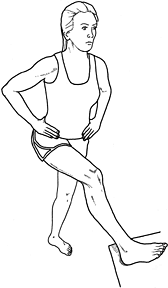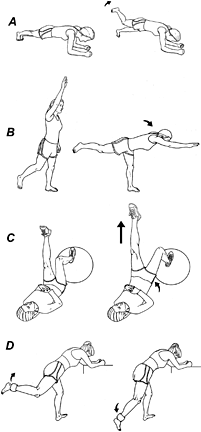New York's highest court of appeals has held that no-fault insurers cannot deny no-fault benefits where they unilaterally determine that a provider has committed misconduct based upon alleged fraudulent conduct. The Court held that this authority belongs solely to state regulators, specifically New York's Board of Regents, which oversees professional licensing and discipline. This follows a similar recent ruling in Florida reported in this publication.
Conservative Management of Hamstring Strains, Part 2
Editor's note: part 1 of this article, which discussed hamstring anatomy / function and mechanisms / risk factors for injury, appeared in the May 20 issue.
The fact that stretching has not been proven to lessen the potential for developing injury does not imply that stretching should be avoided. On the contrary, since a flexible muscle is able to tolerate higher eccentric forces with less muscle damage6 and individuals with flexible hamstrings are less prone to a variety of injuries,7 reducing muscle stiffness with gentle stretches is clinically justified.

The problem is that converting a stiff individual into a flexible individual can take months to years, and may interfere with the storage and return of elastic energy. Because of these different factors, stretching should be prescribed on an individual basis and performed in a gentle manner during the acute stages of injury. The patient should be instructed of the long-term commitment necessary to modify muscle stiffness.
The stretch illustrated in Figure 3 isolates the long head of the biceps femoris muscle. To reduce stiffness in the upper hamstring, this stretch should be performed with the knee flexed 45° and 90°. Since fatigue increases the potential for hamstring injury, Verral, et al.,8 recommend stretching the hamstrings for 15 seconds (with the knee bent at different angles) as the muscle becomes fatigued while exercising. Over a two-year period, the authors demonstrated significantly reduced rates of hamstring injuries in Australian Rules Football players when the stretches were performed during workouts and competition. This may also apply to marathon runners, who present with fatigue-related weakness at the end of their long runs.

Because injury results in protective splinting of the hamstrings and neighboring muscles, it is important to evaluate each muscle of the hip and thigh for the presence of trigger points that might be responsible for increasing muscular stiffness. Since adhesions and/or trigger points may increase tensile strain on the hamstring origin during late swing phase, vigorous deep-tissue massage along the full length of each of the affected hamstring muscles may enhance the transfer of tensile strain through the fascia and perimysium, possibly reducing the potential for muscle-tendon junction injury. Home stretches should be performed following deep-tissue massage with a foam roller, with the goal being restoration of pre-injury flexibility of the entire muscle and its fascial envelope.
Additionally, since it is thought to improve arthrokinetic reflexes, several authors suggest spinal manipulation may play a role in the prevention and treatment of hamstring injuries. In the largest study to date, Hoskins, et al.,9 demonstrated in a randomized, controlled trial that Australian Rules footballers treated before and during a competitive season with occasional chiropractic care had reduced rates of hamstring and total lower-body muscle strains with no adverse outcomes.
While stretches and various manual therapies are helpful when treating hamstring injuries, comprehensive strengthening exercises play the most important role in the management of hamstring strains. In an impressive study comparing the efficacy of different treatment regimens used in the management of acute hamstring strains, Sherry and Best10 showed that compared to a conventional protocol of static stretching and isolated progressive hamstring resistance exercises, an exercise regimen including progressive agility and trunk stabilization exercises produces significantly better short and long-term outcomes. (See Table for a summary of these exercises.)
| ProgressiveStrengthening Exercises for Hamstring Injuries Phase 1
Phase 2
Key: Low intensity: a velocity ofmovement that is less than or near that of normal walking. Moderate intensity: a velocity of movement greater than normal walking but not as great as sport. High intensity: a velocity of movement similar to sport activity. Progressioncriteria: Subjects progressed from exercises in phase 1 to exercises in phase 2 when they could walk with a normal gait pattern and do ahigh-knee march in place without pain. Exercise protocol described by Sherry and Best10 |
Compared to conventional rehabilitation, the agility and stabilization group returned to sport sooner (22 days versus 37 days), and suffered fewer reinjuries during the first two weeks after returning to sport (55 percent of the conventional rehab group were reinjured, compared to no reinjuries in the progressive agility and trunk stabilization group). The beneficial effects of the agility and stabilization exercises were even present one year following return to sport, as 70 percent of the athletes treated with conventional stretches and exercises were reinjured, compared to only 7.7 percent of the athletes completing the progressive agility and trunk stabilization program. The alternate hamstring exercises illustrated in Figure 4 are also helpful when treating gait-related hamstring injuries.
Because nonsteroidal anti-inflammatories may result in impaired tendon healing,11 the routine use of these drugs should be reconsidered. A safer alternative to improve healing is to perform aggressive deep-tissue massage directly over the damaged tendon, as this may stimulate tendon repair without adversely affecting tendon strength.12-13 If pain reduction is important, the typical runner responds well to ice packs applied in 15-minute intervals, 4-5 times per day. Given the recurrent nature and long-term disability associated with hamstring strains, it is important to treat this injury with comprehensive conservative care.
References
6. McHugh M, Connolly D, Eston R, et al. The role of passive muscle stiffness and symptoms of exercise-induced muscle damage. Am J Sports Med, 1999;27:594.
7. Hreljac A, Marshall RN, Hume PA. Evaluation of lower extremity overuse injury potential in runners. Med Sci Sp Exerc, 2000;32(9):1635-1641.
8. Verrall GM, Slavotinek JP, Barnes PG. The effect of sport specific training on reducing the incidence of hamstring injuries in professional Australian Rules football players. Br J Sports Med, 2005;39:363-368.
9. Hoskins W, Pollard H, Orchard J. The effect of sports chiropractic on the prevention of hamstring injuries: a randomized controlled trial. Med Sci Sports Exerc, 2006;38:S27.
10. Sherry M, Best T. A comparison of 2 rehabilitation programs in the treatment of acute hamstring strains. J Orthop Sports Phys Ther, 2004;34:116.
11. Cohen D, Kawamura S, Ehteshami J, Rodeo S. Indomethacin and Celecoxib impair rotator cuff tendon-to-bone healing. Am J Sports Med, 2006;34:362-369.
12. Davidson C, Ganion L, Gehlson G, et al. Rat tendon morphologic and functional changes resulting from soft tissue mobilization. Med Sci Sports Exerc, 1997;2903:313.
13. Loghmani M, Warden S. Instrument-assisted cross-fiber massage accelerates knee ligament healing. J Orthop Sports Phys Ther, 2009;39:506-514.
14. Thelen D, Chumanov E, Hoerth D, et al. Hamstring muscle kinematics during treadmill sprinting. Med Sci Sports Exerc, 2005;37:108-114.


